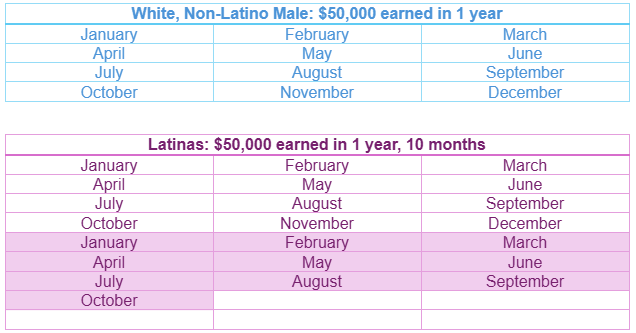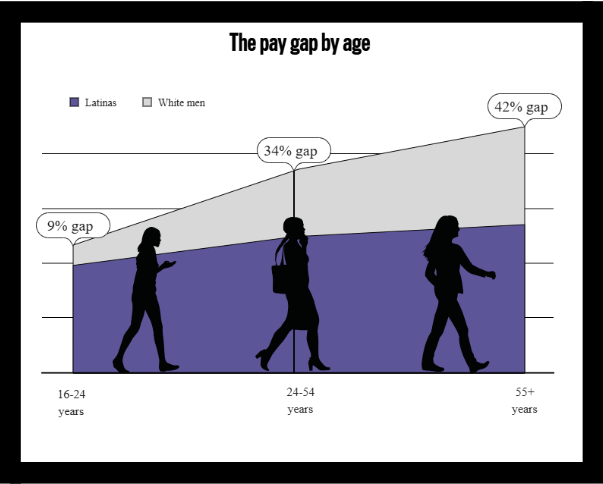By Christina Fernández-Morrow
What Is Latina Equal Pay Day?
Latina Equal Pay Day is the date in the current year when Latinas finally earn what white, non-Hispanic men earned in the previous year.
The Pay Timeline Compared to White Men

This timeline visualizes the gender and racial pay gap: A Latina needs 1 year and 10 months to earn what a white, non-Hispanic man earns in just one year.
The Latina Wage Gap in Numbers
Lost per Month: $2,538
Lost per Year: $30,450
Lost over a Career: $1,218,000
Wages lost due to pay gap:
Even as Latinas have entered the workforce in record numbers totaling some 12.6 million, they continue to face the largest wage gap among women, reflecting systemic barriers that continue to prevent Latina workers from achieving economic equality.
Latinas earn approximately 51-58 cents for every dollar a white, non-Hispanic man earns.
From age 16, Latinas are paid less than white boys the same age—and the gap only grows from there. Over a 40-year career, this wage gap can result in a loss exceeding $1.2 million in earnings for Latinas.
Where we are: 2025
Year Latinas will reach pay equity: 2451

The pay gap between Latinas and white men widens significantly with age, from 9% for young workers to a staggering 42% for those 55 and older.
Latinas are going to college at higher rates than ever before. But…
The pay gap increases for Latinas with professional degrees, causing a loss of over $2.5 million. The gap is largest for Latinas with a bachelor’s degree, who earn 31% less than white men on average and those with advanced degrees earn 27% less.
Latinas ask for promotions and raises at similar rates to white men—yet
- For every 100 men promoted to manager, only 75 Latinas are promoted.
The pay gap is even worse for Latina mothers: they earn 53% less than white fathers.
Why the Pay Gap Exists
- Occupational Segregation: Latinas are disproportionately concentrated in lower-wage industries.
- Lack of Benefits: Many positions held by Latinas offer fewer benefits like paid family leave, making it harder for them to balance work and family care responsibilities.
- Pay Secrecy & History: Practices like prohibiting workers from discussing their pay and asking about salary history perpetuate cycles of underpayment.
- Immigration Status: Undocumented Latinas earning less than their documented counterparts.
Human Impact
When Latinas are paid less, they have less money for basic family necessities like rent, groceries, and school supplies. Over time, this impacts families’ ability to invest in savings, higher education, or property.
Latinas’ Economic Contributions
Latinas are powering U.S. economic growth.
- $661 billion → $1.3 trillion: GDP contribution by Hispanic women grew from 2010 to 2021.
- 51% growth in Latina-driven GDP during that period — 2.7x faster than the non-Hispanic population.
From 2010 to 2021: Latinas with a bachelor’s degree or higher increased 103%.
- Growth rate far exceeded that of highly educated non-Hispanic women.
Solutions to Close the Gap
- Pass Legislation: Support federal bills like the Fairness Paycheck Act to require pay transparency and ban salary history questions, and the Raise the Wage Act to increase the minimum wage.
- Increase Pay Transparency: Encourage employers to disclose salary ranges and conduct pay audits to identify and correct wage disparities.
- Support Unions: Union membership can significantly increase Latina workers’ wages, providing economic justice.
- Invest in Education: Provide access to education and training for higher-paying, in-demand careers.
- Advocate and Raise Awareness: Use social media (e.g., #LatinaEqualPay), share information, and participate in webinars and workshops to educate communities about the wage gap.
Inspired? Meet More Powerful JEFAS! Discover their stories, strategies, and successes.


